
GORDON WILLIAMSON, illustrated by IAN PALMER
KRIEGSMARINE U-BOATS 1939-45

A Type VII U-boat in heavy seas, seen from the flak platform of another of the same class.
Amongst the many onerous terms of the Armistice that Germany signed in 1918 was a demand that all German U-boats were to be surrendered to Great Britain and additionally that all boats still under construction were to be destroyed or dismantled. Germany was also prohibited from building any other submarines, to include merchant vessels, in the future. These demands were subsequently ratified in terms of Articles 188, 189 and 191 of the Treaty of Versailles signed on 28 June 1919. Existing U-boats at the time of signing were distributed to Great Britain, the United States, France, Italy and Japan, where they were the subject of intensive study.
Fortunately for Germany the Allies, though demanding the surrender of all U-boats, seem to have overlooked the huge repository of technical expertise and knowledge represented by the documentary records of the German submarine construction industry. There had been no demand for these records to be surrendered. These essential records were subsequently transferred to the new submarine section of the Torpedo and Mine Inspectorate of the new Reichsmarine - the navy of the Weimar Republic and from there ultimately to the Reich Archives.
Before long, though prohibited from actually building submarines, Germany was actively marketing her expertise in this field, selling U-boat designs to Japan and working in cooperation with shipyards in Argentina, Italy and Sweden. In order to avoid political problems that might come from being seen to be acting against the spirit of the Versailles Treaty, a cover firm, NV Ingenieurskanntor voor Scheepsbouw (IvS), was set up in Holland in July 1922. Although legal technicalities prevented the opening of the company's office in The Hague until 1925, the Firm was run until that time directly from Germaniawerft;s office in Kiel.

U-9 running on the surface. Her crew is dressed in the leather clothing widely worn by U-boat crews. Note in this photograph that the Iron Cross motif, carried by U-9 in honour of the original U-9 of the Imperial Navy, has been fitted to the tower.
Secretly funded by the German Navy, IvS manufactured two submarines for Turkey, the design of which was closely based on the Type UBI1I of the Kaiserliche Marine. Both were launched in 1927, with the contracts worded in such a way that IvS personnel were involved with crew selection and training, and were permitted to take part in the boats' service trials. The Germans thus gained first-hand knowledge of how their design behaved in practice.
In 1932, the Germans decided on a reconstruction programme designed to provide the nation with a modern navy. This programme included provision for a small fleet of eight medium-sized (500-ton) submarines, though this number was later increased to 16. A year later, in 1933, a school for training U-boat crews was established, ironically under the title of 'anti-submarine defence school' (Unterseebootsabwehrschule) at Kiel.
Three mine-laying submarines were also ordered by Finland, again based on an earlier design, this time the Type UCIII, but greatly improved. The boats were built in Finnish shipyards, but with intensive involvement of German technicians who once again participated in their sea trials. Two further orders were received from the Finns, one for a small 115-ton vessel, and one for a larger 250-ton boat, very similar to what would become the MVBII. The last of these, the Vesikko, launched in May 1933, had her hand-over to the Finnish Navy deliberately delayed until January 1936 so that she could be used for the purpose of training future U-boat crews. The Vesikko is still preserved today.
Germany now began to develop designs for submarines for her own navy. These projected designs, for the purpose of subterfuge, were referred to as Motorenversuchsboote (MVB) or 'Experimental Motor Boats'. Deutsche Werke in Kiel was selected to build the new boats, and a new U-boat base was to be constructed at Kiel-Wik.
Component materials began to be surreptitiously gathered at Deutsche Werke's Kiel base, ready for the order to begin production. The programme envisaged the following types being built:
1934 - two large 800-ton boats and two small 250-ton boats
1935 - four small 250-ton boats
1936 - two large 800-ton boats and six small 250-ton boats
1937 - two large 800-ton boats and six small 250-ton boats

Stern view of the Type IIB. Just abaft the conning tower is the crew access hatch into the interior. On the second boat from snore, a crewman can just be seen exiting from this hatch. The stem flagstaff is held in a fitting that also contains the stern navigation light.
Each small boat was costed at between I and 1.5 million marks, including preparation costs, and each large boat at between 4 and 4.5 million marks. The larger boats were designated as MVBIA and the smaller as MVBIIA.
The Anglo-German Naval Agreement of 1934 had agreed a proportional parity of 3:1 between the two countries. With Great Britain's submarine fleet totalling just over 50,000 tons, this would allow Germany (had the construction of U-boats been permitted at all) a fleet totalling around 17,500 tons. This was initially perceived as being 20 of the MVBIA type and six of the smaller MVBIIA type. In fact, however, naval theory was much in favour of large numbers of the smaller type being more effective than a smaller number of large boats. A figure of around ten of the larger boats and 18 of the smaller was arrived at, still leaving Germany well within her theoretical tonnage allowance.
All of this was somewhat academic, however, as Germany still was not in a position where she was allowed to build submarines of any type. Hitler, who had come to power in January 1933, still harboured hopes of an accord with Great Britain and did not wish his political plans to be upset by any discovery that Germany was building prohibited U-boats. Permission to begin construction was therefore withheld for the time being.
Meanwhile, the Unterseebootsabwehrschule continued with its theoretical training for future U-boat crews, and design work on other models also progressed. An improved version of the MVBII, the MVBIIB was designed, with a lengthened hull to provide additional fuel bunkerage and thus extended endurance. With three approved designs, it was clear that Deutsche Werke alone could not build sufficient numbers rapidly enough to meet demands, and the decision was taken to distribute the various types to additional shipbuilders. Deutsche Werke at Kiel would build the MVBII A, Deschimag-AG Weser the MVBIA and Germaniawerft the MVBIIB. By the autumn of 1934 sufficient materials and components had been stockpiled for construction to begin, but still Hitler held back, not approving the commencement of work until 1 February 1935.

Close-up of the conning tower of U-9. The Iron Cross emblem was removed on the outbreak of war. The horseshoe-shaped object just above the Iron Cross is, in fact, a life preserver.
Further models had been considered, including the MVBIII, a large development of the MVBIA, which would serve as a minelayer as well as earning two motor torpedo boats; the MVBIV, which would be a seagoing workshop/supply/repair submarine serving the main combat units of the U-boat fleet; the MVBV, which was to have a new propulsion system designed by Walter; and finally the MVBVI, which was to have a new design of steam-driven engine. All of these types were ultimately rejected in favour of the MVBVII, a medium 500-ton design destined to become the Type VII, the backbone of the U-boat fleet during the Second World War. Once again, this latest model was to be based upon the successful UBIII design of the First World Wan Although the MVBII was subsequently further developed to produce the IIC and IID variants, its further development potential was limited. The MVBVII, basically an enlarged MVBII, was a far more versatile design and was further transformed into a bewildering number of variants and sub-variants through the course of the Second World War. The first orders for the building of the MVBVII type were issued in January 1935, just two months before Hitler formally repudiated the terms of the Treaty of Versailles and rearmament began in earnest. Around this time the 'MVB' prefix was dropped.
One of the least successful of U-boat designs, only two Type IAs were ever built. Constructed by the Deschimag yard, U-25 and U-26 were to be the only boats of their type, though this model was a direct forebear of the later, much more successful Type IX.
SPECIFICATIONS
Length - 72.4 m
Beam - 6.2 m
Draft - 4.3 m
Displacement - 862 tons surfaced, 983 tons submerged
Speed - 17.8 knots surfaced, 8.3 knots submerged
Endurance - 6,700 nautical miles surfaced, 78 nautical miles submerges
Powerplant - 2 × 1,540 bhp MAN diesels coupled with 2 × 500 bhc electric motors
Armament - 6 torpedo tubes (4 bow, 2 stern), 14 torpedoes 1 × 10.5 cm gun; 1 × 2 cm gun
Crew - 43
The two boats of this type were used predominantly on training duties until 1940 when the general shortage of available boats required their use in combat. In fact, both boats were relatively successful in terms of their combat successes.
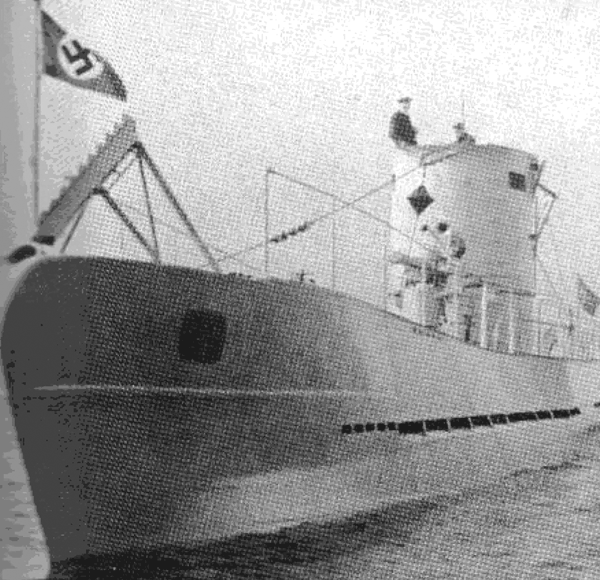
A pre-war photo, dating from around 1936, of U-25, the first of the Type IA boats. Note the very pale grey paint scheme used post-war. The net cutter at the bow of most U-boats was removed prior to the outbreak of war. Normally, the jump wire was attached to the top point of the net cutter where this was fitted, but in this case has been attached to the decking near to the bow. The safety railings were normally only fitted when in port.
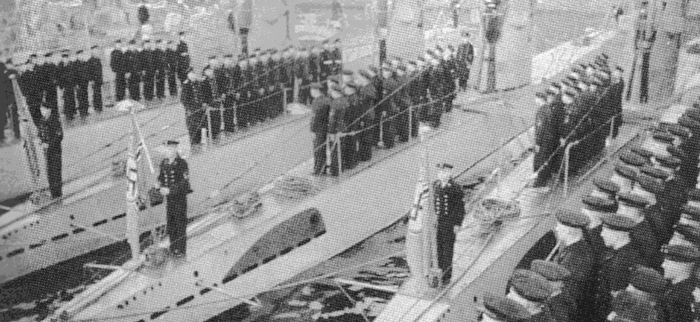
Type IIAs with their crews mustered on deck in their best blues as the new war flag of the navy, the Reichskriegsflagge, is ceremoniously raised for the first time on 7 November 1935. Note the dark-painted portion of the hull side near the stern. The round hole at the forward end of this is the diesel exhaust vent. The dark-painted area was to disguise unsightly exhaust staining to the pale grey hull.
U-25 carried out a total of five war cruises, sinking eight enemy ships totalling some 50,250 tons. Her first (pre-war) commander was Korvettenkapitän Eberhardt Godt who was eventually to become Commander-in-Chief U-boat Operations in the late stages of the war. His successor as commander was Korvettenkapitän Victor Schütze, who would become one of Germany's top U-boat 'aces' with a total of 35 ships (180,000 tons) sunk. Passing through a recently laid enemy minefield on 3 August 1940, she struck one of the mines and sank with all hands.
U-26 carried out eight war cruises. On her first cruise, she was employed on minelaying duties, and was rewarded by the sinking of three merchant ships and the damaging of one British warship by mines laid by her. On her second cruise she became the first U-boat of the war to enter the Mediterranean, though the remainder of the cruise was uneventful. Her third cruise saw her add a further three merchant ships to her score in a brief sortie into the Atlantic. The fourth cruise saw her being used for transport duties during the Norwegian Campaign, though she sank a 5,200-ton merchantman during her return trip from one of her transport sorties. After three more uneventful patrols, U-26 set off on her eighth war cruise on 20 June 1940. Three merchantmen were sunk on 30 June, and on the next day an attack damaged a further merchant ship. The attack was followed by a severe depth-charging from two British warships that forced U-26 to the surface where she was bombed by a Sunderland flying boat. The crew were forced to scuttle her, die majority being rescued by their attackers.
Despite both boats having relatively successful, if short, combat careers, they were technically not particularly good sea boats, especially when considering that they were intended as oceangoing rather than coastal vessels. Their stability was poor, their diving speed slow, and their manoeuvrability under water not impressive. Nevertheless, with 13 war cruises and 18 ships sunk between them, the Type IAs had acquitted themselves well.
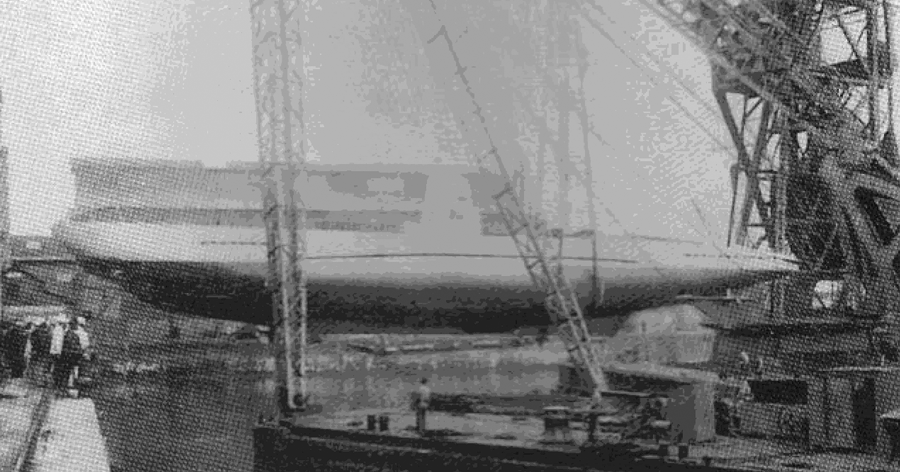
One of the diminutive Type IIB boats being lowered into the water by crane. Their light weight and small size permitted this style of launching, as compared to the larger boats which were normally built on a slipway in a manner similar to conventional craft.
The Type II was a natural enough progression from the UB coastal types of the Kaiserliche Marine in the First World War. Small, cheap and easy to build, they could be produced in a remarkably short time. Based on the CV-707 export design produced for Finland between the wars, the Type II made excellent training vessels, but due to their small size and tendency to roll heavily when on the surface they were rather contemptuously referred to as Einbäume or 'canoes' by the Germans. Nevertheless, several of this type acquitted themselves well in combat operations as well as in training, and a number of variant types were produced. All carried just three bow torpedo tubes in an unusual inverted triangle arrangement with one each to port and starboard and a third below them on the boat's centre line.
A total of just six Type IIAs were built.
SPECIFICATIONS
Length - 40.9 m
Beam - 4.1 m
Draft - 3.8 m
Displacement - 254 tons surfaced, 301 tons submerged
Speed - 13 knots surfaced, 6.9 knots submerged
Endurance - 2,000 nautical miles surfaced, 71 nautical miles submerged
Powerplant - 2 × 350 bhp MWM diesels coupled with 2 × 180 bhp electric motors
Armament - 3 bow torpedo tubes, 6 torpedoes carried, 1 × 2 cm flak gun
Crew - 25
The Type IIB was basically a lengthened version of the IIA, the additional hull capacity allowing a greater fuel load to be carried, thus enhancing the boat's endurance. Five seconds were also shaved off the critical time taken to dive the boat, a reduction from 35 to 30 seconds. A total of 20 Type IIBs were built, the largest number of any sub-type.
SPECIFICATIONS
Length - 42.7 m
Beam '- 4.1 m
Draft - 3.9 m
Displacement - 279 tons surfaced, 329 tons submerged
Speed - 13 knots surfaced, 7 knots submerged
Endurance - 3,900 nautical miles surfaced, 71 nautical miles submerged
Powerplant 2 × 350 bhp MWM diesels coupled with 2 × 180 bhp electric motors
Armament - 3 bow torpedo tubes, 6 torpedoes carried, 1 × 2 cm flak gun
Crew - 25
Once again, this boat was simply a lengthened version of its immediate predecessor, with increased bunkerage. The Type IIC also had a lengthened control room and a second periscope. The Type IIC can easily be identified on photographs by the flush front to the tower, rather than the stepped front found on the IIA and IIB. Only eight Type IICs were built.
SPECIFICATIONS
Length - 43.9 m
Beam - 4.1 m
Draft - 3.8 m
Displacement - 291 tons surfaced, 341 tons submerged
Speed - 12 knots surfaced, 7 knots submerged
Endurance - 4,200 nautical miles surfaced, 71 nautical miles submerged
Powerplant - 2 × 350 bhp MWM diesels coupled with 2 × 205 bhp electric motors
Armament - 3 bow torpedo tubes, 6 torpedoes carried, 1 × 2 cm flak gun
Crew - 25
The Type IID, but for its small size, might almost pass for a Type VII with its enlarged conning tower with rear flak platform, and its distinctive saddle tanks. It had greatly increased range, and more up-to-date self-compensating fuel bunkers. 16 Type IIDs were manufactured.
SPECIFICATIONS
Length - 44.0 m
Beam - 5.0 m
Draft - 3.9 m
Displacement - 314 tons surfaced, 364 tons submerged
Speed - 12.7 knots surfaced, 7.4 knots submerged
Endurance - 5,680 nautical miles surfaced, 71 nautical miles submerged
Powerplant - 2 × 350 bhp MWM diesels coupled with 2 × 205 bhp electric motors
Armament - 3 bow torpedo tubes, 6 torpedoes carried, 1 × 2 cm flak gun
Crew - 25
Ideally, all of the Type II vessels would have been relegated to training duties by the outbreak of war in September 1939. However, as Germany was nowhere near its intended submarine strength by this point, the need for operational Frontboote meant that many Type IIs had to be pressed into combat service. As the number of available Type VII and Type IX vessels increased, so Type IIs were released from combat service, once again for use with the training flotillas. By mid-1941, all Type IIAs and Type IIBs had been returned to training duty. Almost all of the Type IICs were used during the invasion of Norway before they too were gradually released back to the training flotillas.
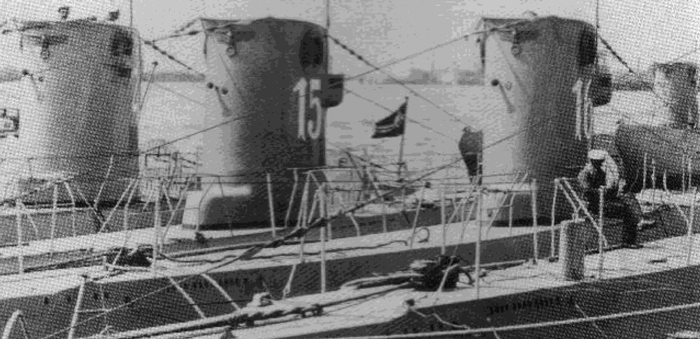
This photograph shows U-2 (a Type IIA) at extreme left, next to U-15 and U-16, both Type IIBs. Note the flush front of the conning tower on the Type IIA and early Type IIBs, making the two visually very similar. The projecting housing on the side of the tower for the navigation lights is the only significant difference in appearance.
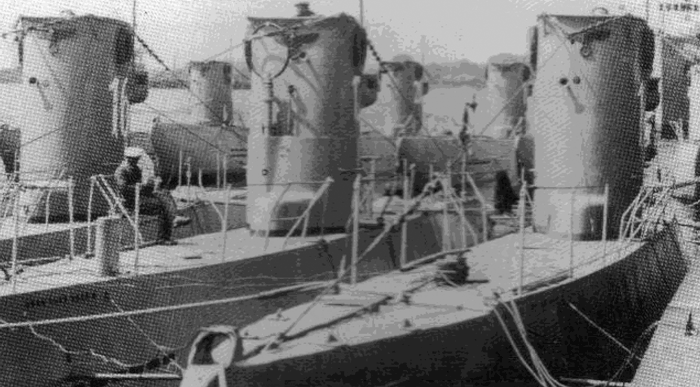
Three Type IIBs. The centre boat, U-12, built by Germaniawerft, has a stepped front to the tower, on which is fitted a DF loop. The other two boats pictured are Type IIBs from Deutsche Werke, with flush front to the tower.
Of the six Type IIA boats, U-1 was sunk by a mine, and all of the others took part in support operations in the invasion of Norway with U-2, U-5 and U-6 returning thereafter to training duties. U-3 had a slightly more eventful career, carrying out five war cruises and sinking two enemy ships before being relegated to training duties. U-4 took part in four war cruises, sinking three enemy ships and a British submarine, HMS Thistle, before joining the training flotilla.
Of the 18 Type IIB boats, many returned to training duties after the invasion of Norway. A total of 150 war cruises were carried out by these small coastal boats, however, with 97 enemy merchant ships and nine enemy warships being sunk. Though small, they had served their purpose well.

An early pre-war photo of a Type IIB, possibly U-9, shows the extremely narrow hull which gave these boats their nickname of 'canoes'.
Six of the Type IIB vessels (U-9, U-18, U-19, U-20, U-22 and U-23) were despatched to the Eastern Front for service in the Black Sea against Soviet shipping. The diminutive size of these boats allowed them to be partially dismantled and loaded onto barges to be transferred as far as possible along inland waterways, then loaded onto large flatbed trailers and transported by road. These obsolescent boats succeeded in sinking a number of enemy ships. As fortunes on the Eastern Front went into reverse, it became impossible to consider taking them back to Germany by the same route. They were offered to Turkey and, on this being refused, were scuttled to prevent them falling into Soviet hands.
Of the eight Type IIC boats that were built, only one (U-63) was lost to enemy action. All of the others eventually returned to training duties after the type had completed a total of 56 war cruises and sunk 57 enemy ships, including three warships.
A total of 16 Type IIDs were produced, many of which went directly into the training flotillas and saw no action whatsoever Those that did participate in combat sorties completed a total of 36 war cruises, resulting in 27 enemy ships being sunk, including three warships. One was lost to a depth-charge attack by enemy destroyers and one was sunk by an enemy submarine. The others all served out the war in the various training flotillas.
We have much more interesting information on this site.
Click MENU to check it out!
∎ cartalana.com© 2009-2025 ∎ mailto: cartalana@cartalana.com